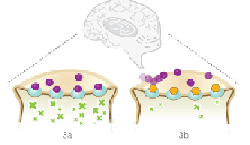 |
| Buprenorphine (orange) binds to the mu opioid receptors in the brain to block opioids from attaching to them. Titan hopes to commercialize the implant to deliver the drug, which is currently available in sublingual tablet and oral formulations.--Courtesy of Titan Pharmaceuticals |
Braeburn Pharmaceuticals is confident about FDA approval of its Probuphine subdermal implant to treat opioid addiction after its pivotal trial demonstrated it worked at least as well as sublingually administered buprenorphine/naloxone. But an unexpected rejection of the candidate by the FDA in 2013 means the outcome is far from certain.
The trial was not only double-blind but double-dummy, meaning patients on the Probuphine buprenorphine/naloxone-delivering implant received daily sublingual pills, and those taking sublingual buprenorphine pills received four placebo implants (thus all patients received a dummy and placebo form of therapy).
Braeburn said the implant passed the test of noninferiority. More than 96% of the 84 patients in the Probuphine arm responded to therapy, meaning they spent at least 4 out of 6 months free of illicit opiates, compared to 87.6% among the 89 patients in the control group, who received sublingual pills.
A Titan spokeswoman previously explained changes to the second, now-completed trial, writing in an email: "The current trial was designed to address the FDA's main concern that the Probuphine dose used in the earlier studies was too low for the kind of patients who were being tested, and the clinical benefit would be greater in a different patient population. Specifically, the patients in the earlier studies were new to medication treatment, and required a 12-16 mg/day dose of sublingual buprenorphine to achieve clinical control over withdrawal symptoms and opioid cravings. The patients in the current study are considered clinically stable by their treating physician and have received a maintenance dose of less than or equal to 8 mg/day of sublingual buprenorphine for at least 3 months prior to randomization."
The product uses Titan's ProNeura drug delivery system. "The continuous drug delivery system consists of a small, solid rod made from a mixture of ethylene-vinyl acetate and a drug substance," Titan explains on its website. It is typically placed subdermally in the upper arm and delivers buprenorphine for 6 months. Titan also says that the delivery system has shown promise as a treatment for Parkinson's disease in nonclinical studies.
In 2013, the FDA also expressed concern about "human factors testing of the training associated with Probuphine's insertion and removal." Braeburn says 23% of Probuphine patients had an implant site adverse event; that's higher than 13.5% of those in the control group.
The implant delivers buprenorphine, which is currently available in sublingual tablet and oral formulations--a market with 2012 annual sales of about $1.5 billion in the U.S.
If approved, the product would be the "first and only commercialized treatment of opioid dependence to provide continuous, around-the-clock blood levels of buprenorphine for 6 months following a single procedure," Kate Glassman-Beebe, Titan's chief development officer, said in a prior statement.
"Today's results bring us one critical step closer to our goal of making long-acting buprenorphine products available to patients," said Braeburn CEO Behshad Sheldon in a statement. "We are grateful to the FDA for providing guidance on the study design and to our investigators for helping execute it. We hope these results pave the way for Probuphine, if approved by FDA, to become a uniquely effective option in addiction treatment, enabling patients to manage their treatment more conveniently and giving doctors confidence that medicine is delivered as intended, without worrying about it getting into the wrong hands or unintentionally harming children."
- read the release